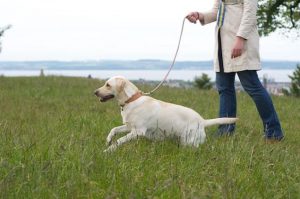From Pulling to Polite
May 15, 2017

We’re not living in a one size fits all world, and dogs and dog training are no exception. To that end, I’ve listed several methods below as well as a few training tips and pointers:
Right From the Start One of the best ways to make your life easier and impact the quality of the walk is to train a sit or stand to get ‘dressed.’ Getting dressed may mean putting on a collar or harness and/or clipping on the leash. Either way, getting equipment on a squiggly jumping dog can be frustrating and time-consuming. When you pick up your dog’s equipment, ask for a sit once. If your dog gets up without a verbal release, put the equipment down. Pause for a second or two, then try again. Allow your dog to work through his frustration (and take a lot of deep breaths yourself!). A few minutes of this work can literally translate to years of polite behavior. *Tip* Teaching a small dog to sit or stand on a chair to be leashed up is perfectly acceptable. It can save you from bending over and can limit some of his movement as well.
Exit Like a Gentleman or Lady You’ve had your dog sit or stand on cue to get his swag on, but now he’s racing out the door like a runaway train. Hold up! As we mentioned above, training polite behavior takes patience but oh! is it sooo worth it. Here are videos one and two that describe simple training for nixing door dashing. Although both videos mention clicker training, you can substitute well-timed praise in the place of a click.
Exercise First Some pulling on leash happens because our dogs have excess energy and they’re simply in need of exercise. If at all possible during the training phase, try playing fetch in your yard or home, tug of war, or have a quick play session in a dog park before hitting the trail.
Practice Without Distractions Loose leash walking can be one of the most challenging skills that we teach our dogs. While we tend to introduce and practice other skills initially without distractions, we often start leash walking around tons of distractions. Ruh roh! People, dogs, traffic, squirrels, birds, and etc are all par for the course on a typical walk. Consider the tips in this video, starting inside the house or in an area with very low distractions.
Penalty Yards So you’ve gotten out of the house and onto the sidewalk in a civilized manner — but your dog has suddenly launched ahead. Time to issue penalty yards! Without jerking your dog, begin backing up, praising and rewarding your dog as soon as he’s following you. If you have his attention, begin moving forward again. Repeat as needed.
The Canine Cha-Cha as coined by Grisha Stewart is related to playing penalty yards but with [literally] a twist. It’s a bit more proactive rather than just a consequence for pulling. “Teach your dog that any pressure on the leash means that he should return to you. On your walk, even if he is not pulling, suddenly walk backwards. You are walking backwards and he turns around to face you, so he’s walking forwards, but the opposite direction of before. When he turns to look where his feet are taking him, give him a treat. Repeat – over and over and over. If he pulls ahead, back up as well.”
Reward Right Position Whenever your dog is walking at your left or right side (pick the side you prefer and stick with it), praise and reward. Your praise and treat should be given quickly as you continue moving forward. Very small and soft treats as well as a great treat bag help! *Tip* Young puppies don’t multi-task well so they may need to stop and eat, rather than eat and walk.
Keep me posted on your progress and thanks for reading!
By Susan Marett








